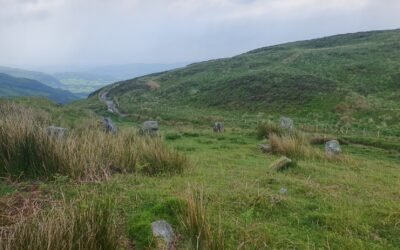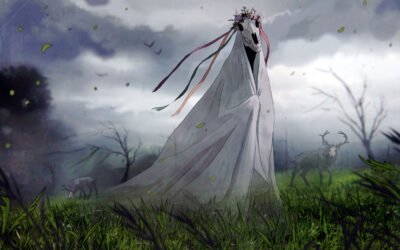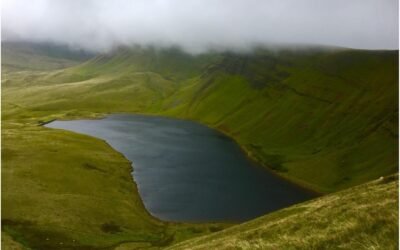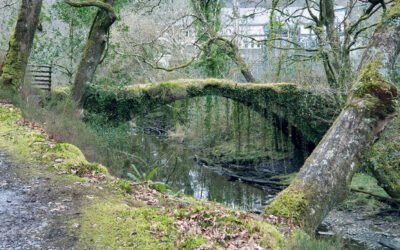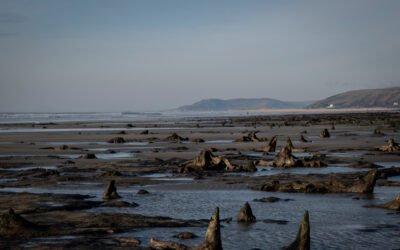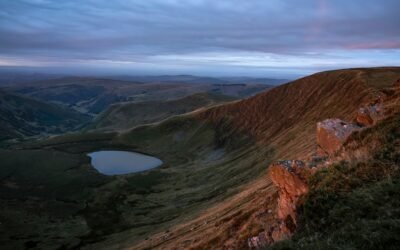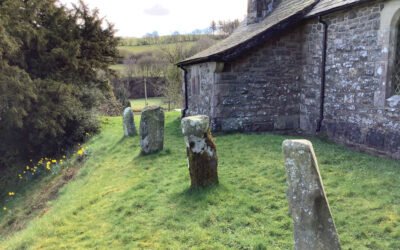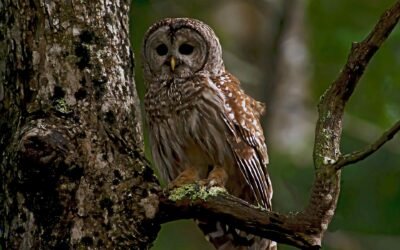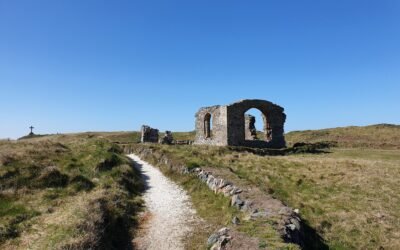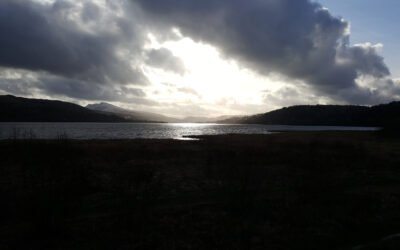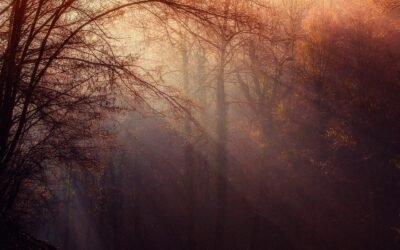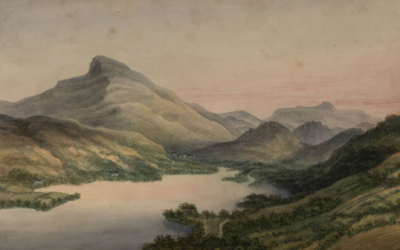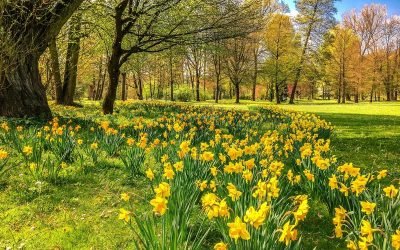Our News
Two Mounds and a Circle: “The Irishman’s Church”
High above the Dyfi Estuary and within the beautiful valley known as Cwm Maethlon is a stone circle known as Eglwys Gwyddelod, which means “the Irishman’s Church”.
The Milk of Kindness
Stories of magical or miraculous cows, some of whom freely gave their milk to whole neighbourhoods and never seemed to run dry are fairly common in Britain; there are several examples in Wales, also Shropshire, Lancashire and Warwickshire, to name just a few. For this Welsh version we visit a remote valley called Dyffryn Gwyn, close to Llyn Barfog, or “Bearded Lake”, itself in Cwm Maethlon (near Aberdyfi in Gwynedd.
Nearby lived a poor farmer who somehow managed to capture one of the milk-white cows that would sometimes appear in the company of mysterious women dressed in green. He added the cow to his own herd and the milk, butter and cheese produced from the cow and her calves were considered the best ever, making the farmer very rich indeed. But the ungrateful man forgot that all his good luck was owed to the cow and he decided to fatten her for the butcher, fearing that she was growing old.
Mari Lwyd – a Horse at Midwinter
If you live in south Wales, especially Glamorgan or Monmouthshire, a strange procession might appear at your door sometime around Christmas or New Year. A leader, perhaps smartly dressed, with a motley crew of men, two of them dressed as Punch and Judy, the latter wielding a broom or rolling pin. Sometimes there would be a merryman, who would play music. Most remarkably of all, the chief character is the white skull of a horse mounted on a pole and carried by someone concealed by a sheet. Usually there are ribbons or some kind of decoration added to the skull and sometimes springs fitted to the jaw to facilitate a clacking sound.
After knocking, the company would begin to sing or speak in verse, asking for entry. You’re expected to reply in kind, refusing to let them in. They would persist and once you have run out of excuses or failed to make up more lyrics on the spot, you must allow entry and give the group food and ale. The horse may well misbehave and chase people around the house, while Punch and Judy will join in with the general chaos, with Judy also perhaps putting out the fire and sweeping the floor.
Skeleton Trees and Swan Maidens – Samhain 2023
What could be sadder and spookier at Samhain than the 18th century tale of Meinir and Rhys, childhood playmates who grew up to find true love together? They lived at Nant Gwrtheyrn, a tiny place near Llithfaen on Llŷn, and planned to marry at St Beuno’s church in Clynnog-Fawr, a few miles away. Perhaps they plighted their troth at their favourite spot, an oak tree on Yr Eifl, one of the highest hills on the Lleyn peninsula.
Monstrous Women and Magic Mushrooms: Autumn Equinox 2023
Perhaps St Twrog was looking for a place to build his third church as he journeyed along the old Roman road, Sarn Helen, for at the ford crossing the Afon Dwyryd (at present-day Maentwrog) he found what he needed to begin construction of a basic cell, a place to live while his larger plans bore fruit. Withies grew in abundance and could be woven quickly, while the marsh provided plenty of mud, clay or animal dung: together they make wattle and daub, an immediate reminder of history lessons to generations of British schoolchildren.
What he may not have expected was to come across the locals worshipping what is variously described as a “demoness” or “she-devil” at an altar there. Ordering the monstrous female to leave at once had no effect and the two fought, wrestling for half a day, but neither could gain the advantage. At length, they agreed a short truce and Twrog climbed up into the Moelwynion, central Snowdonia mountains which do rather loom over the village, and there he prayed and rested to regain his strength.
The Undrowned Goddess: Imbolc 2023
Not very far from Bala tales have been told for centuries of an entire flooded kingdom, gaining a greater audience since a storm in 2019 pounded the shores of Borth and Ynyslas in Ceredigion, uncovering the remains of trees – pine, alder, oak and birch – that had been buried for thousands of years. Evidence perhaps of the lost lands known as Cantre’r Gwaelod or “Lowland Hundred”, governed by Gwyddno Garanhir, born around 520 CE, from his palace, Caer Wyddno, near Aberystwyth. It’s claimed that the land stretched some 20 miles out into what is now Cardigan Bay. A sophisticated system of sea walls and gates kept the land, which was below sea level, safe, while water was allowed in to irrigate the fields and pastures, for an acre of land here was worth any four elsewhere. In many versions of the tale the job of closing the sea gates fell to the watchman, Seithenyn, but after enjoying himself at a feast rather too much he forgot one night and so the land was drowned.
Away with the Fairies: A UFO Crash in the Berwyn Mountains? Yule 2022
Once thought to contain the mysterious realm of Annwn, or land of the dead, the Berwyn Mountains lie south and east of Bala but although the highest peak – Cadair Berwyn, at 830 metres – is shorter than some half-dozen Snowdonia mountains this fascinating area, full of wildlife and of stark beauty, is well worth visiting. And rather less full of tourists, there is peace aplenty here, not to mention enigmatic folklore and legends, a number of which strongly suggest the presence of Goddess as the old woman who built and dwells still in her landscape.
Cerridwen’s Mirror: Samhain 2022
Approaching the small town of Y Bala in North Wales from almost any direction means a trip through wilder lands: mountains and moors, liminal landscapes that somehow do little to prepare one for that first view of the lake, Llyn Tegid, giant mirror of the sky in all its moods, angry or calm, grey or glas – a Welsh word meaning anything from azure to greenish-blue and thus not easy to translate.
The Nanteos Cup – a Holy Grail in Wales? Autumn Equinox 2022
Does the Holy Grail exist in this earthly realm? Certainly there are many who believe that a vessel with healing powers is to be found here in Britain, perhaps in Glastonbury. But the Nanteos Cup now in the National Library of Wales is also thought by many people to be the grail – as are many other containers throughout the world. But what exactly is the grail?
Finding Ffraid: Brigid in Wales and further afield: Lammas 2022
Brigid, Bride, Bridie, St Bridget – it sometimes seems that there are as many Brigids or Brides as there are places named for her: springs and wells, churches, rivers, hills and fields, even whole towns. In Wales she is usually called Ffraid, pronounced “Fride”, and is almost always found as San Ffraid or Sant Ffraid, although there are variations here too. While looking at maps for places named for Ffraid, I noticed that a large proportion were on or near the coast, which makes sense when reading about her arrival in Wales. But more of this later.
Gwenfrewy: silent saints and headless maidens: Summer Solstice 2022
“If I can’t have you I’ll make sure no-one will!”
All too many women hear this phrase and it can make the blood run cold. Perhaps Prince Caradoc said it to Gwenfrewy—better known today as St Winifride—when he cut off her head after she refused his “attempted familiarities”. The prince had been hunting and, becoming thirsty, called at her parents’ home in what would become Holywell in Flintshire for a drink of water, where he found the young woman home alone.
Maidens and Owls: Blodeuwedd at Beltane – 2022
A beautiful young woman comes slowly to consciousness, at first seeing only chaotic colours and shapes. Then a man bends and whispers some words to her while helping her to stand. And you see her face change as the colours begin to resolve into a world of trees, mountains fading to blue in the distance, and a whole carpet of flowers at her feet. She looks up at the man and then, as though remembering her purpose, smiles winningly at him, invitation in her eyes.
An Ostara Tale: Hares and Hounds, Shape and Meaning: Spring Equinox, 2022
The fire is settling to a red glow and pools of darkness expand, but the audience hardly notices and nobody moves as the bard gets to the thrilling part of the story of Cerridwen and Gwion Bach – the shapeshifting chase. Even small children are quiet, barely breathing as they wait to hear what happens next.
Dwynwen: “She who leads a blessed life”: Imbolc 2022
Who needs St Valentine when we have our own British matron saint of lovers? Not only do we have the fascinating story of Dwynwen but also her breathtaking island, Ynys Llanddwyn, to visit on pilgrimage, as people have done for hundreds—if not thousands—of years.
Newsletter – Yule 2021
We’re so happy to be able to send newsletters out at last! We hope to send them at each of the eight festivals of the Wheel of the Year, in future with information about the Temple, our events and the local area. But for this first time – well, now Keli and Ian are back at last, Geraldine Charles interviewed Keli to get the full story of how the Goddess Temple of Bala came about… it’s also Ian and Keli’s wedding anniversary at the Winter Solstice, so wishing them the happiest of days!
The Goddess, Sir Gawain and the Green Knight – Yule 2021
“Morgan the Goddess” is probably the last person I’d expect to meet in a late 14th century English poem, even if that composition were set in a mythic past—after all, Christianity had been well established in Britain for centuries by this time and that’s certainly demonstrated in the rest of Sir Gawain and the Green Knight.
Hags and Crones – Samhain 2021
Interestingly, Samhain, the name used in much of the Celtic world for this fire festival, means something like “Summer’s End”, while the Welsh term, Nos Calan Gaeaf, approximates to “the First of Winter”. And Winter is what we prepare for, the dark and cold as we approach the Winter Solstice and despite a hint of change as days then grow longer the dormancy of nature seems to continue for a long time yet and Imbolc can seem so far away!
Who is Mabon ap Modron? – Autumn Equinox 2021
Ever wondered why some people call the Autumn Equinox festival “Mabon”? The name doesn’t really do much to suggest an equinox – these mark the time when day and night are roughly equal in length, so of course at the autumn one we’re moving into the darker half of the year.
Seeking Elen – Lammas 2021
So much of the evidence for Elen of the Ways and her roads leads one to suspect a much earlier original date than those usually suggested, and it’s exciting and truly staggering to realise that Elen may well date back to the Stone Age. Rather like Ceridwen, another hugely important goddess in Wales, she is returning from the mists today as we find new ways to work with and honour our beautiful and ancient landscape.
Unpathed Waters, Undreamed Shores: Watery Tales from Llyn Tegid – Summer Solstice 2021
There are so many stories about Llyn Tegid, Bala Lake, the surrounding landscape and rivers. Let’s start with a tale of how the lake came to exist:
Ceridwen and her Cauldron – Beltane 2021
There are a number of magical cauldrons in Celtic folklore. To name but a few, we have the Pair Dadeni (the cauldron of rebirth), which originally belonged to Bran Fendigaid (Bran the Blessed), and which can revive dead warriors. Another, known as the Cauldron of Plenty, was one of the four treasures of the Tuatha Dé Danaan. From this cauldron, everyone of good character could eat their fill and the cauldron never ran out.
The Fires of Spring – Spring Equinox 2021
… by the Spring Equinox we can see and feel the sun’s fire strengthening and warming the soil, with precious small green signs of life renewing everywhere… trees and plants bud and blossom, birds and bees do what they do, and the Goddess moves towards her full expression as Spring Maiden. There are many names for this season, and you may know it as Eostre, Ostara or Alban Eilir, to name but a few.


